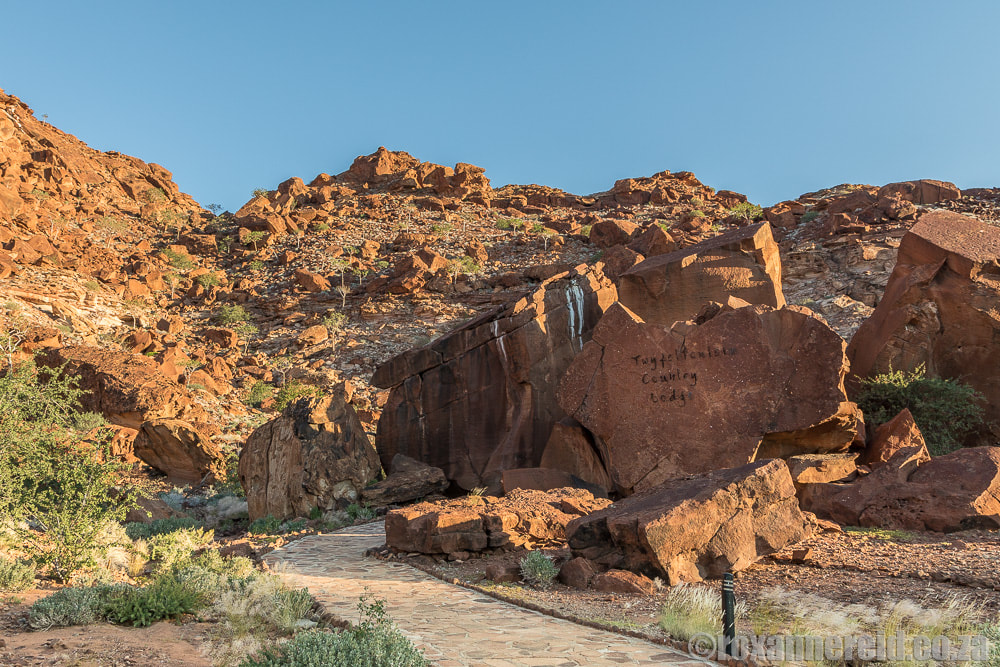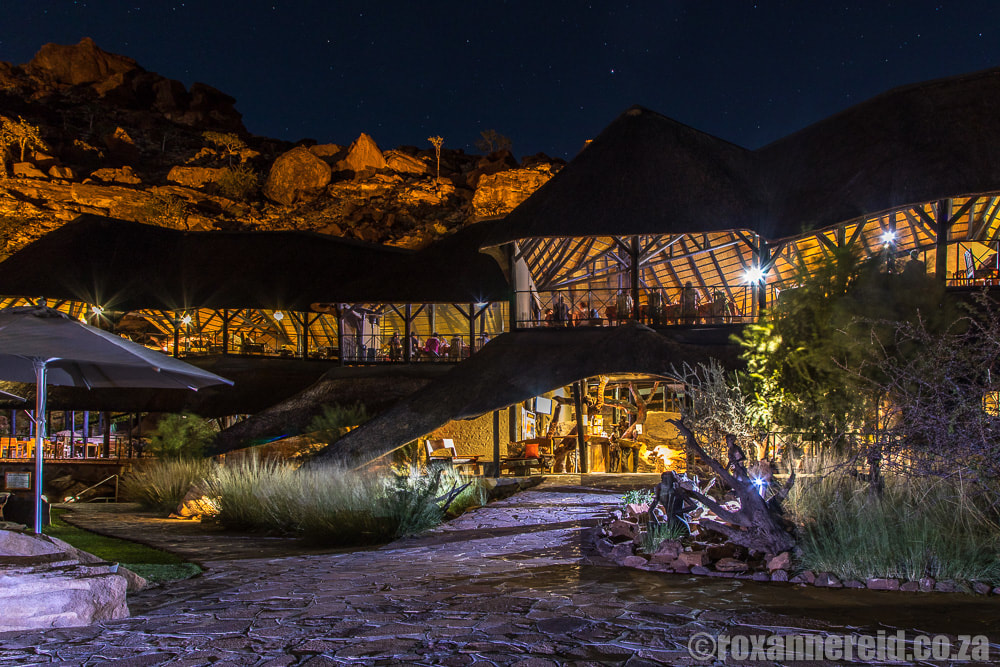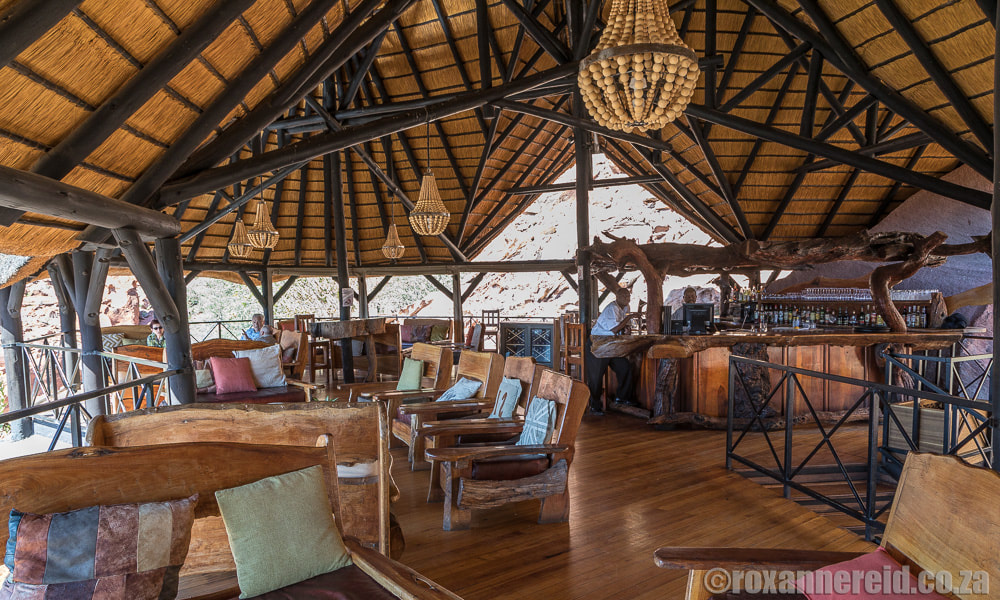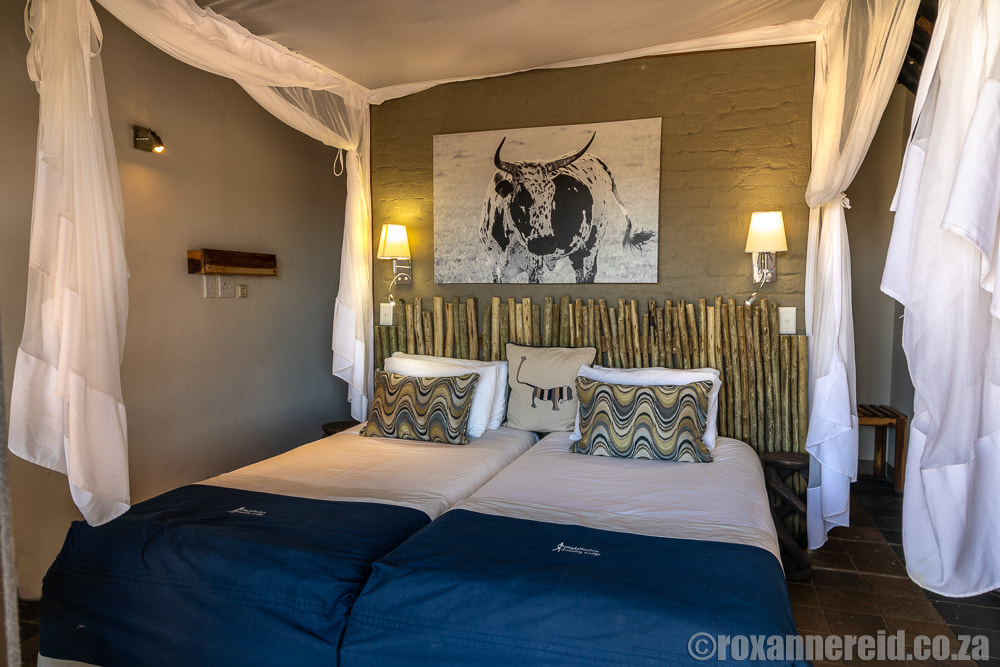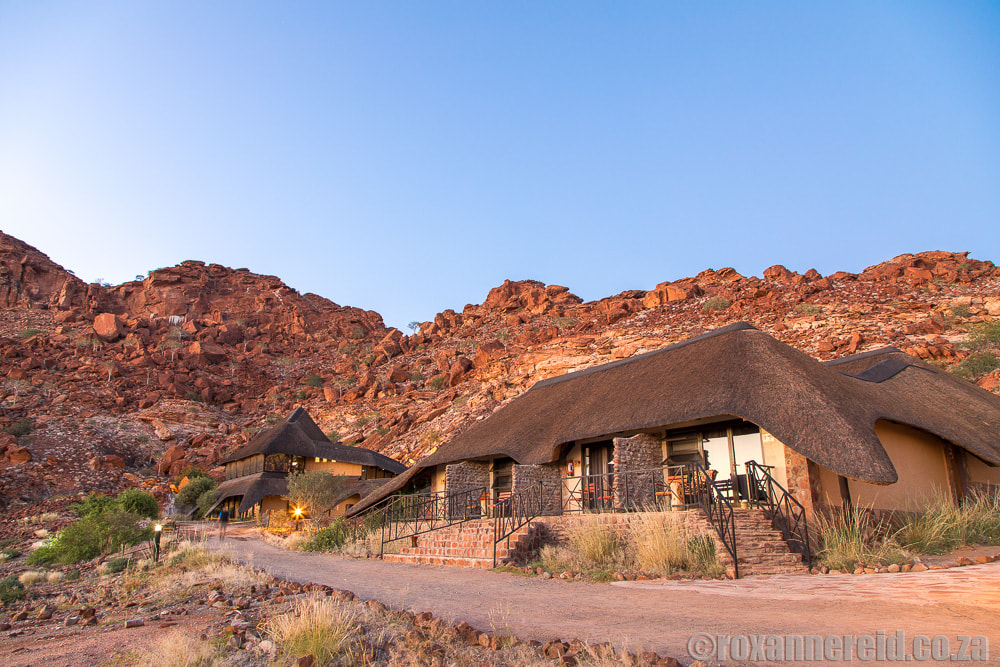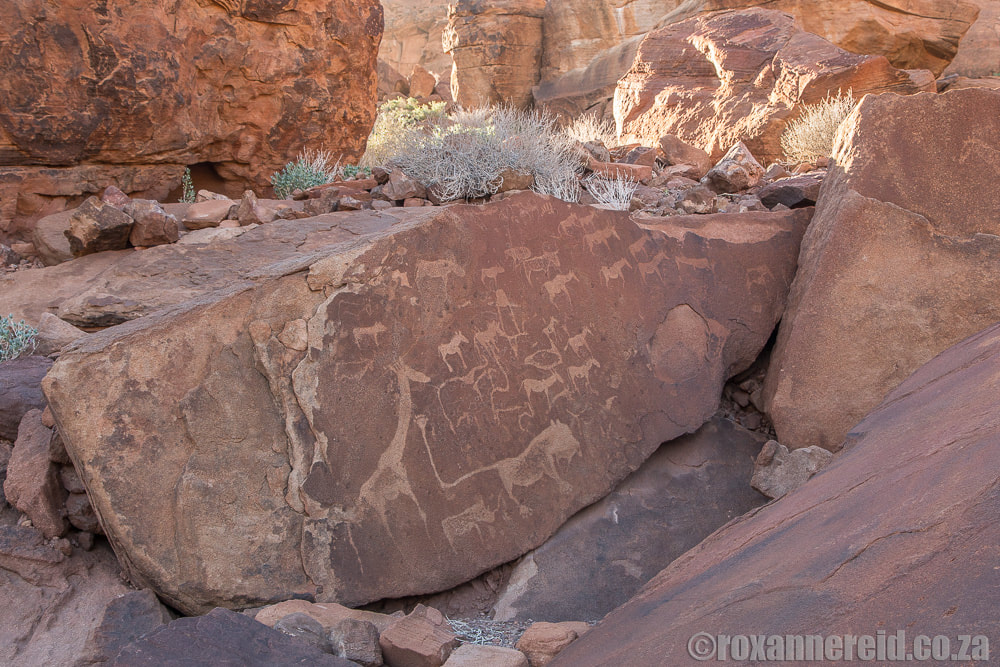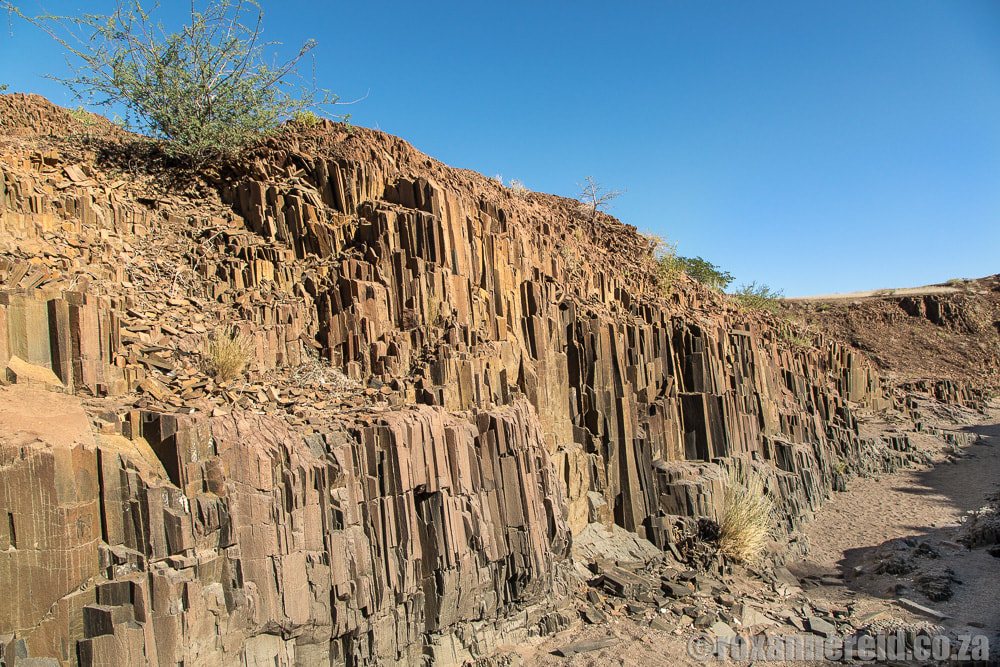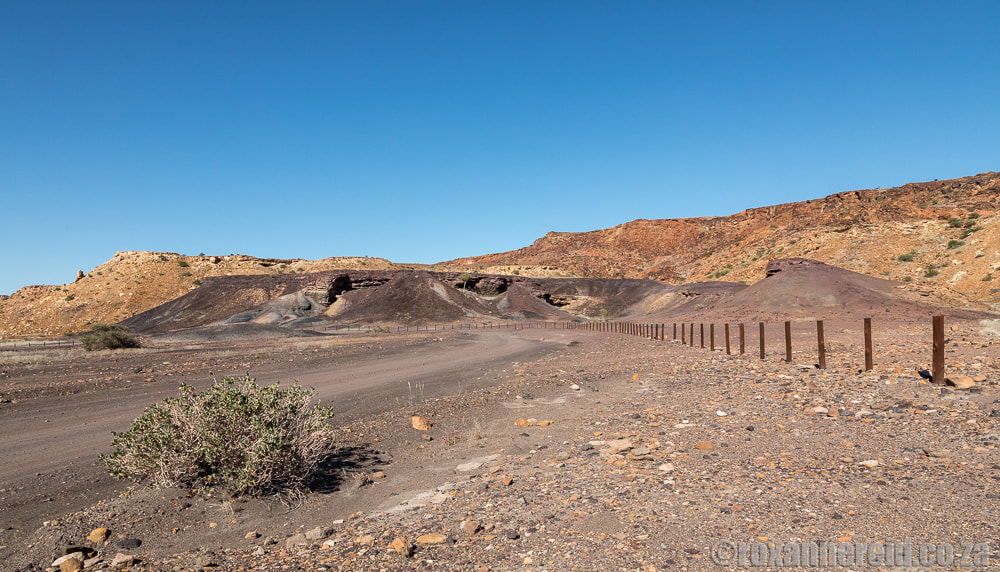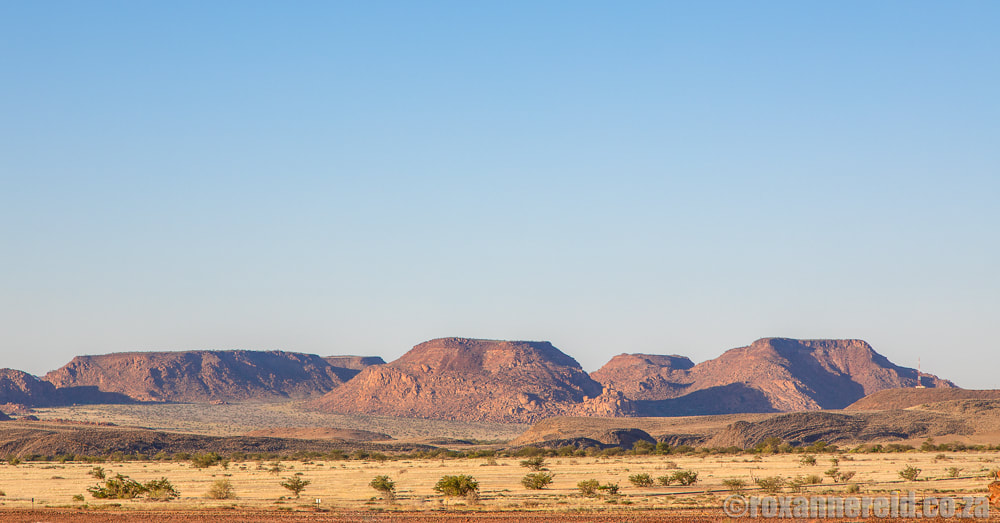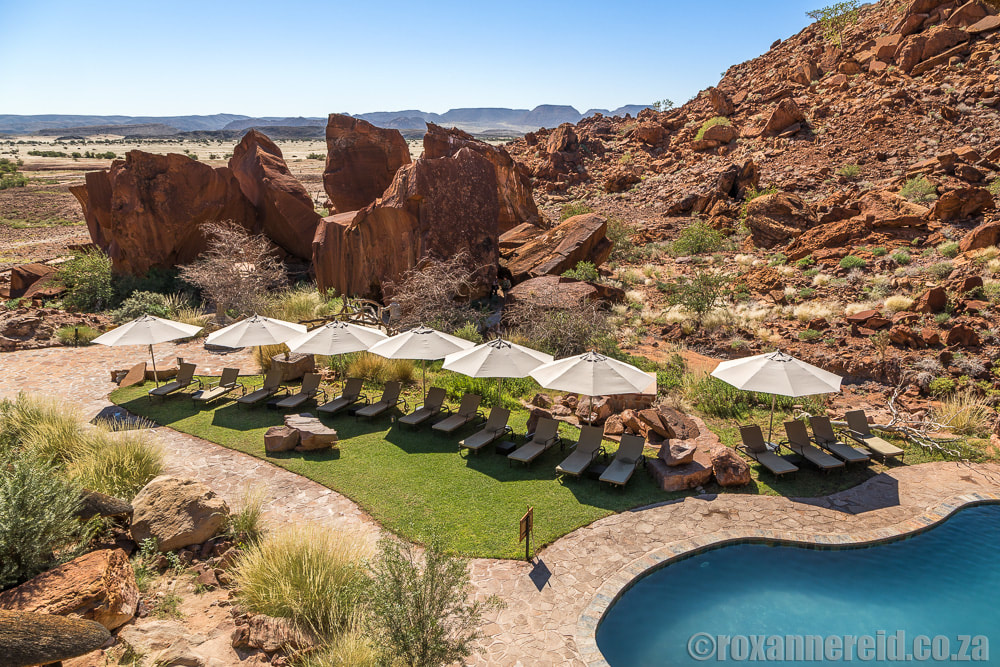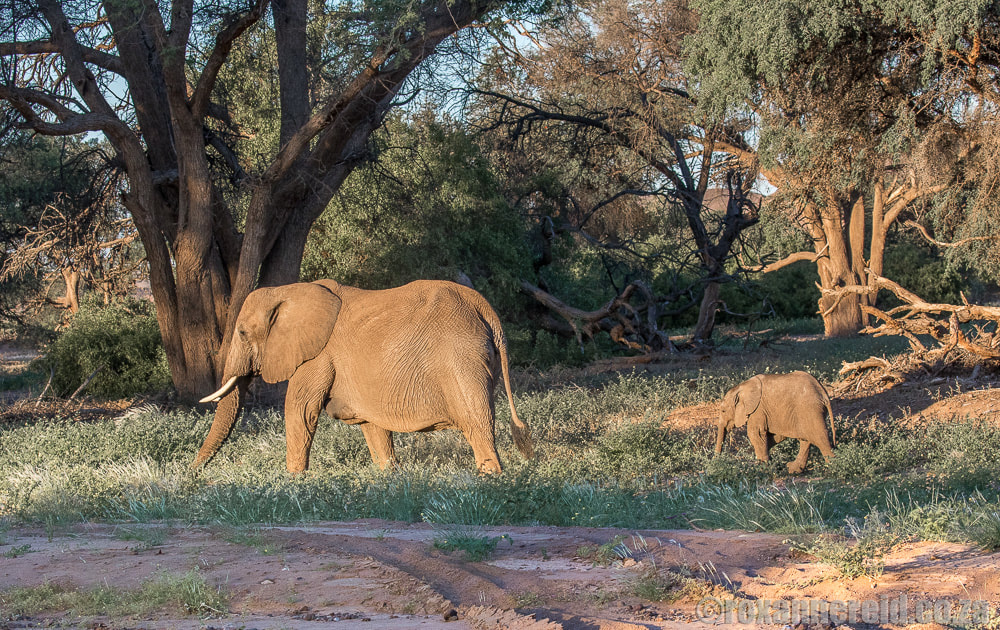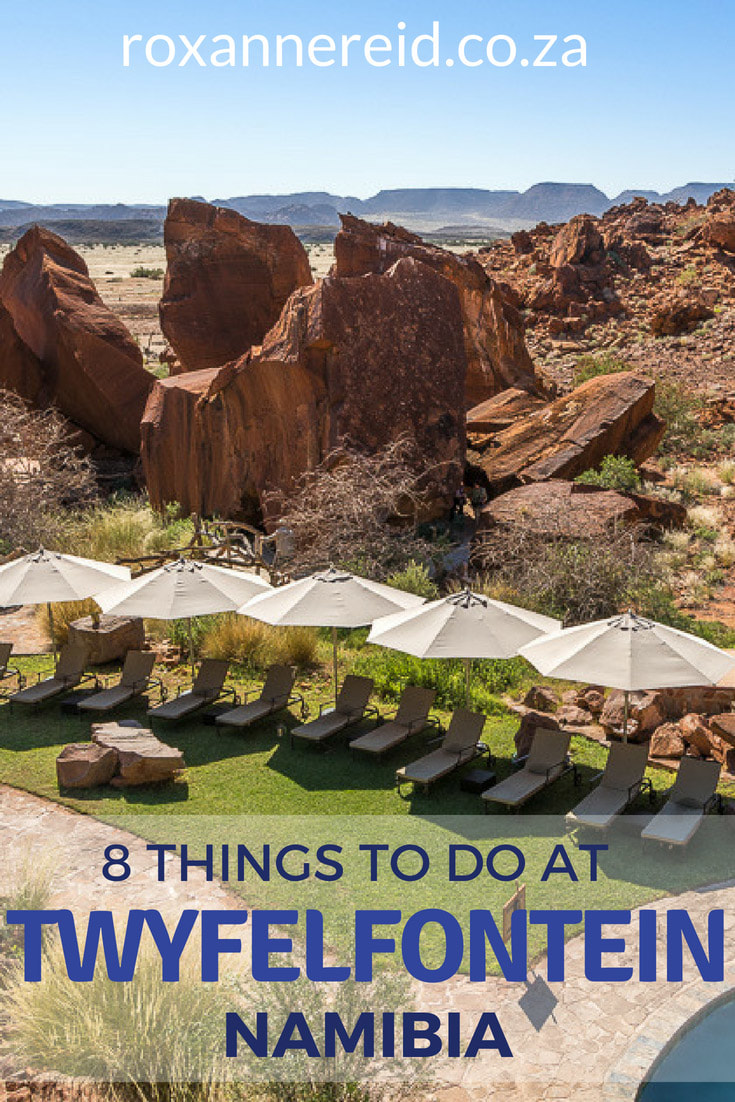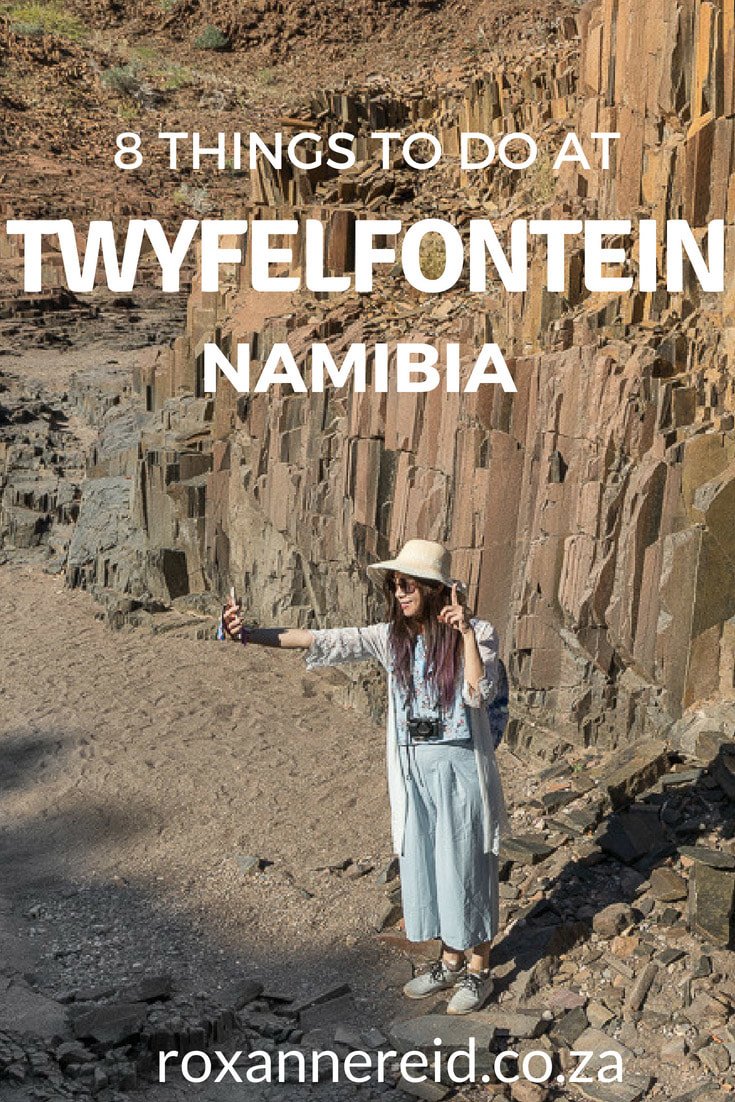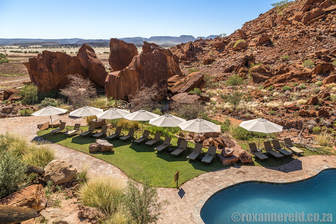
By Roxanne Reid
Late afternoon and the heat had ebbed. From the stoep of our room at Twyfelfontein Country Lodge we watched the sun burnish the rocks, silky grasses ripple on the plains and distant mountains march along the horizon. A mountain chat chirped and a lizard came to visit. It was a reminder why Namibia is such a rewarding destination. Here are 8 reasons to visit Twyfelfontein.
Late afternoon and the heat had ebbed. From the stoep of our room at Twyfelfontein Country Lodge we watched the sun burnish the rocks, silky grasses ripple on the plains and distant mountains march along the horizon. A mountain chat chirped and a lizard came to visit. It was a reminder why Namibia is such a rewarding destination. Here are 8 reasons to visit Twyfelfontein.
Tucked into the curve of the hills, Twyfelfontein Country Lodge is about 100km from Khorixas in the Huab Valley of Kunene (which used to be known as Damaraland). It melts into a background of red sandstone rocks, an otherworldly environment that begs to be used as a set for a futuristic movie.
You’ll love those rocks at dawn and dusk, when they’re at their most attractive, but hate them in the middle of the day when they seem to draw and hold the heat. It can get to 55 degrees here in summer and even when we were there in late May it reached a toasty 30 degrees one day.
You’ll love those rocks at dawn and dusk, when they’re at their most attractive, but hate them in the middle of the day when they seem to draw and hold the heat. It can get to 55 degrees here in summer and even when we were there in late May it reached a toasty 30 degrees one day.
As you arrive, the vast reception/dining/bar area hides behind giant rocks, to be slowly revealed as you walk through a winding rock tunnel. It’s welcome shade to cool off in during the middle of the day. Don’t miss the ancient engravings in an alcove just next to where the tunnel widens out to show off the lodge with its open bar and lounge areas that overlook the swimming pool and the rocks beyond.
Sink into one of the couches under a high thatched ceiling dotted with wooden bead chandeliers. Both here and in the rooms, natural stone, thatch and earthy colours blend with the surroundings. Order a drink from the bar – the draught beer is ice cold and delicious on a hot day. The lounge and bar areas are also great places from which to watch Namibia’s sunset fireworks, but I preferred the solitude of our own stoep, where the buzz of people was far away, the only sounds those of nature.
Although some rooms face the rocks behind, ours faced the plains in front. On our second day we learnt our lesson about the heat of the sun, so here’s a tip: when you go out, even if it’s in the cool of early morning, leave the curtains closed to keep the sun off the front windows so your room is a bit cooler in the afternoon.
Dinner in the huge upstairs dining room that overlooks the pool is a buffet – everything from starters, soup and salads, to a carvery of chicken, beef and game meat. For me, the array of veggies was a welcome touch in a country that generally seems obsessed with meat. My travel buddy was especially keen on the dessert table.
After dinner, the staff gave a concert of enthusiastic singing, with a little swaying and stomping thrown in for good measure. It sent us to bed with smiles on our faces.
At breakfast, you can help yourself to another buffet that includes fresh fruit, pastries, cold meats and cheeses, as well as the usual bacon and sausage. Order eggs as you like them from the hot grill and you’ll have enough fuel to last till dinner time. If not, never fear, people come from far and wide to see the sights around the lodge, so there’s always plenty of food at lunchtime too.
After dinner, the staff gave a concert of enthusiastic singing, with a little swaying and stomping thrown in for good measure. It sent us to bed with smiles on our faces.
At breakfast, you can help yourself to another buffet that includes fresh fruit, pastries, cold meats and cheeses, as well as the usual bacon and sausage. Order eggs as you like them from the hot grill and you’ll have enough fuel to last till dinner time. If not, never fear, people come from far and wide to see the sights around the lodge, so there’s always plenty of food at lunchtime too.
Things to do in the area
Do you love being active and seeing new sights, or do you prefer to laze your way through the day? No matter what gets you excited, you’ll be spoilt for choice here.
1. Discover a Petrified Forest
On the way from Khorixas, stop to see the Petrified Forest about 50km northeast of Twyfelfontein. No, it’s not a standing forest, but a collection of fossilised trees lying flat. You can try to do the walk of about 800m on your own, but in my opinion it’s worth paying a professional guide to enrich your experience.
Beverly Afrikaner explained how the trees were flushed down from Central Africa in a flood 280 million years ago. When they settled, they were covered in mud, and minerals like iron oxide, silica and magnesium penetrated to turn them to stone. The site was discovered by locals in the 1940s after they were exposed by erosion.
The first one we saw was about 1.2m diameter and 10m long, fully exposed on the surface. ‘The petrified trees are twice as heavy as normal stone,’ said Beverly, dumping a small broken-off hunk of it in our hand to prove her point.
One of the petrified trunks is hollow, which you can hear clearly when you knock on it. ‘Oxygen must have penetrated to rot the inside before the outside became petrified,’ she explained. On some of the trees you can see bark preserved in stone.
Do you love being active and seeing new sights, or do you prefer to laze your way through the day? No matter what gets you excited, you’ll be spoilt for choice here.
1. Discover a Petrified Forest
On the way from Khorixas, stop to see the Petrified Forest about 50km northeast of Twyfelfontein. No, it’s not a standing forest, but a collection of fossilised trees lying flat. You can try to do the walk of about 800m on your own, but in my opinion it’s worth paying a professional guide to enrich your experience.
Beverly Afrikaner explained how the trees were flushed down from Central Africa in a flood 280 million years ago. When they settled, they were covered in mud, and minerals like iron oxide, silica and magnesium penetrated to turn them to stone. The site was discovered by locals in the 1940s after they were exposed by erosion.
The first one we saw was about 1.2m diameter and 10m long, fully exposed on the surface. ‘The petrified trees are twice as heavy as normal stone,’ said Beverly, dumping a small broken-off hunk of it in our hand to prove her point.
One of the petrified trunks is hollow, which you can hear clearly when you knock on it. ‘Oxygen must have penetrated to rot the inside before the outside became petrified,’ she explained. On some of the trees you can see bark preserved in stone.
The longest tree we saw was 31m exposed above the ground, though there is more that’s still buried.
Your guide will also point out various plants of interest, such as that Damaraland special, the welwitschia. You’ll learn that white-barked commiphora is used by the Damara for woodcrafts, brown-barked commiphora by the Himba for perfume, and that euphorbia (milkbush) has a poisonous latex that Bushmen used on their arrow tips to paralyse an animal. Once the animal collapsed, the hunters would go closer and kill it with their spears, then cook the meat twice to get rid of the effect of the poison.
2. Explore the Twyfelfontein engravings
A 4-5km drive from the lodge takes you to Twyfelfontein, where your entrance fee pays for a professional guide to take you around this UNESCO World Heritage Site. Sylvia Thanises told us there are about 43 000 engravings in Namibia. The ones here are between 2000 and 6000 years old, from the Late Stone Age.
They’re named after a spring discovered by farmer David Levin in 1946. He was looking for water but wasn’t sure if he would find it – hence the name (twyfel is Afrikaans for doubtful or uncertain). You can still see the ruins of his farmhouse. The Damara name is /ui-//aes, which means water among rocks.
Your guide will also point out various plants of interest, such as that Damaraland special, the welwitschia. You’ll learn that white-barked commiphora is used by the Damara for woodcrafts, brown-barked commiphora by the Himba for perfume, and that euphorbia (milkbush) has a poisonous latex that Bushmen used on their arrow tips to paralyse an animal. Once the animal collapsed, the hunters would go closer and kill it with their spears, then cook the meat twice to get rid of the effect of the poison.
2. Explore the Twyfelfontein engravings
A 4-5km drive from the lodge takes you to Twyfelfontein, where your entrance fee pays for a professional guide to take you around this UNESCO World Heritage Site. Sylvia Thanises told us there are about 43 000 engravings in Namibia. The ones here are between 2000 and 6000 years old, from the Late Stone Age.
They’re named after a spring discovered by farmer David Levin in 1946. He was looking for water but wasn’t sure if he would find it – hence the name (twyfel is Afrikaans for doubtful or uncertain). You can still see the ruins of his farmhouse. The Damara name is /ui-//aes, which means water among rocks.
In the cool air of early morning, we kept to the path through mopane bushes before stopping at a ‘blackboard’ of engravings on a large rock, representing animals like rhino, zebra and giraffe, animal tracks and waterholes. ‘These engravings were used to teach young hunters, so as a means of communication and education, whereas Bushman paintings were part of storytelling,’ she explained.
The artists used white quartz to engrave the soft sandstone, creating one of the largest collections of rock petroglyphs in Africa – more than 5000 individual depictions. German Rheinhard Maack discovered them in 1921 and UNESCO declared the area a World Heritage Site in 2007.
At another platform, there are more giraffe and rhino. Perhaps surprisingly, there are even a penguin and a seal, proving that these nomadic people travelled to the coast 200km away, probably for salt. Most of the engravings appear to be of rhino – a sad reminder all these thousands of years later that modern man is conspiring to poach these ancient beasts to extinction.
Sylvia left the centrepiece of the Twyfelfontein engravings for last – a lion that has a very long tail with five fingers at its tip. Called a lion man, it represents a shaman, or someone who enters a trance state during a ritual to practice healing and foretelling – the only such representation at Twyfelfontein.
3. Visit the Organ Pipes
The artists used white quartz to engrave the soft sandstone, creating one of the largest collections of rock petroglyphs in Africa – more than 5000 individual depictions. German Rheinhard Maack discovered them in 1921 and UNESCO declared the area a World Heritage Site in 2007.
At another platform, there are more giraffe and rhino. Perhaps surprisingly, there are even a penguin and a seal, proving that these nomadic people travelled to the coast 200km away, probably for salt. Most of the engravings appear to be of rhino – a sad reminder all these thousands of years later that modern man is conspiring to poach these ancient beasts to extinction.
Sylvia left the centrepiece of the Twyfelfontein engravings for last – a lion that has a very long tail with five fingers at its tip. Called a lion man, it represents a shaman, or someone who enters a trance state during a ritual to practice healing and foretelling – the only such representation at Twyfelfontein.
3. Visit the Organ Pipes
These dolerite pillars along a riverbed formed during a volcanic event 120 million years ago when the continent of Gondwana was breaking apart. Liquid lava intruded into slate, and as it cooled and contracted, the rock split vertically, forming straight, narrow pieces of rock that look just like organ pipes – hence the name. Over time, erosion has exposed them for us to admire. Twyfelfontein Country Lodge’s guide Leonardo Bezuidenhout told me that as pieces broke off, the ancient locals shaped them for use as tools. The site is particularly impressive in the middle of the day when early morning or late afternoon shadows don’t spoil the effect.
4. See Burnt Mountain
4. See Burnt Mountain
About a kilometre past the Organ Pipes is Burnt Mountain, which embodies some impressive stats: a 1000-degree volcanic reaction, a 12km-long volcanic ridge, an 80-million-year-old stream of lava turning rocks into intriguing black and purple colours. Despite these big numbers and the fact that Burnt Mountain has been a national monument since 1956, it looks a bit like a tailing pile left over from mining activity. Nonetheless, it’s worth seeing because it’s so close to Twyfelfontein and you don’t even have to get out of your car unless you want to.
5. Discover the region’s culture
5. Discover the region’s culture
Visit the Damara Living Museum to see what traditional life used to be like for the Damara people. The Bushmen and the Damara are Namibia’s oldest tribes but little of this culture remains today, except in a museum like this. Help to support the community who created and work at the museum, watch the blacksmith make tools, see how they make clothes from animal skins, enjoy traditional games, songs and dance. Go on a bush walk to learn how women collect plants for food and medicine; let the men show you how they used to hunt and set traps in the old days.
6. Go bush walking
Join one of the Twyfelfontein lodge’s guides for an early morning bush walk, from 90 minutes to about four hours. Absorb the wilderness atmosphere and see plants like welwitschia, moringa and commiphora species at close quarters. You may spot some birds or tracks along the way too. Take water, a hat and sunscreen in both summer and winter, and add a warm jacket in winter.
7. Relax at the pool
7. Relax at the pool
If you’re hot and tired from your exploring, cool off with a swim in the lodge’s pool, or simply veg out on a lounger in the shade of a big umbrella. Listen to the tinkling of the fountain nearby, read a book, or simply fall into a relaxing doze.
8. Enjoy a nature drive
Take a guided drive along an ephemeral river in one of the lodge’s 4x4s for a chance to see and learn about ancient welwitschia plants, birds, antelope, fairy circles and changing landscapes with different rock formations in the Doro Nawas Conservancy. If seeing a real life desert elephant is on your wish-list, you may get lucky. When we visited, they were quite far from the lodge, but we managed to find a small family group of six on what turned out to be a four-hour drive. It was one of the highlights of our lives.
8. Enjoy a nature drive
Take a guided drive along an ephemeral river in one of the lodge’s 4x4s for a chance to see and learn about ancient welwitschia plants, birds, antelope, fairy circles and changing landscapes with different rock formations in the Doro Nawas Conservancy. If seeing a real life desert elephant is on your wish-list, you may get lucky. When we visited, they were quite far from the lodge, but we managed to find a small family group of six on what turned out to be a four-hour drive. It was one of the highlights of our lives.
Once the excitement of finding desert-adapted elephants is over, enjoy a drink and snacks on a dune while you watch one of Namibia’s unrivalled sunsets. On the drive back to the lodge, revel in a sky full of stars. If you’re lucky, it will be a moonless night, allowing the Milky Way and other constellations to shine at their brightest in this clean, dry air.
Even if you don’t go on the nature drive, you can still enjoy some stargazing. Try to walk a little away from the lodge’s lights at night to see the black sky filled with masses of stars.
Like it? Pin this image!
Even if you don’t go on the nature drive, you can still enjoy some stargazing. Try to walk a little away from the lodge’s lights at night to see the black sky filled with masses of stars.
Like it? Pin this image!
You may also enjoy
Highlights of Damaraland and Kaokoveld, Namibia
Namibia’s Desert Rhino Camp isn’t all about rhinos
Damara Mopane Lodge’s edible gardens, Namibia
Copyright © Roxanne Reid - No words or photographs on this site may be used without permission from roxannereid.co.za
Highlights of Damaraland and Kaokoveld, Namibia
Namibia’s Desert Rhino Camp isn’t all about rhinos
Damara Mopane Lodge’s edible gardens, Namibia
Copyright © Roxanne Reid - No words or photographs on this site may be used without permission from roxannereid.co.za
